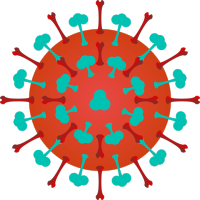| disease | Renal Cortical Abscess |
Renal cortical abscesses are primarily (90%) caused by hematogenous spread of Staphylococcus aureus from distant infection sites (often skin infections). Common predisposing factors include intravenous drug use, diabetes, and hemodialysis. Ascending infections rarely cause renal cortical abscesses. Initially, small abscesses form and gradually enlarge, eventually merging into thick-walled inflammatory masses filled with pus. These may ultimately rupture through the renal capsule to form perinephric abscesses. Most renal cortical abscesses are unilateral (97%) and predominantly affect the right kidney (63%).
bubble_chart Clinical Manifestations
Renal cortical abscesses predominantly occur in young and middle-aged patients between 20 and 40 years old, with a male-to-female ratio of 3:1. The typical clinical features include sudden onset, shivering, fever, lumbago, and tenderness at the costovertebral angle. In the early stages of the disease, before the abscess ruptures into the renal pelvis and calyces, urinary symptoms are absent. Physical examination may sometimes reveal swelling in the lumbar region, a painful mass in the flank, and the disappearance of physiological lumbar lordosis.
bubble_chart Auxiliary Examination
Laboratory tests: Blood tests show moderate to grade III leukocytosis with a left shift. Before the abscess ruptures into the renal pelvis and calyces, the urine is normal, urine cultures are sterile, and blood cultures are often negative. Depending on the severity of renal lesions and functional impairment, serum creatinine and blood urea nitrogen may be normal or elevated. In diabetic patients with renal abscess, urine glucose is positive, and blood sugar is elevated.
Imaging studies: Imaging is necessary for the diagnosis and differential diagnosis of renal cortical abscess. Excretory urography usually reveals only nonspecific changes. As the renal cortical abscess enlarges, space-occupying sexually transmitted disease lesions may be detected. Gallium (Ga67) citrate and indium In111-labeled leukocyte radionuclide scans can aid in diagnosis. Renal B-ultrasound can confirm the presence of a renal cortical abscess when it coalesces and forms a thick-walled mass filled with pus. However, in the initial stage [first stage] of abscess formation, renal ultrasound may misdiagnose the abscess as a renal tumor. Similarly, renal stirred pulse angiography cannot distinguish between a renal abscess and an ischemic or cystic renal tumor. The most accurate imaging modality for diagnosing renal abscess is CT scanning. Percutaneous aspiration of pus under ultrasound or CT guidance not only confirms the diagnosis and identifies the causative organism but also establishes a drainage route for treatment.
bubble_chart Treatment MeasuresThe traditional treatment approach combines antibiotics with surgical drainage. Recently, antibiotics alone have successfully cured renal cortical abscesses, particularly those caused by Staphylococcus aureus. Recommended antibiotics for Staphylococcus aureus infections include methicillin (100–200 mg/kg intravenously every 4 hours), vancomycin (1 g intravenously every 12 hours), and cefazolin (2 g intravenously every 8 hours). These antibiotics can be rotated, administered intravenously for 10–14 days, followed by oral administration for an additional 14–28 days. If no improvement is observed after 48 hours of treatment, resistant bacterial strains or concurrent conditions such as perinephric abscess should be considered. In such cases, percutaneous abscess drainage under ultrasound or CT guidance is required. If no significant improvement occurs after drainage, surgical intervention becomes necessary.






